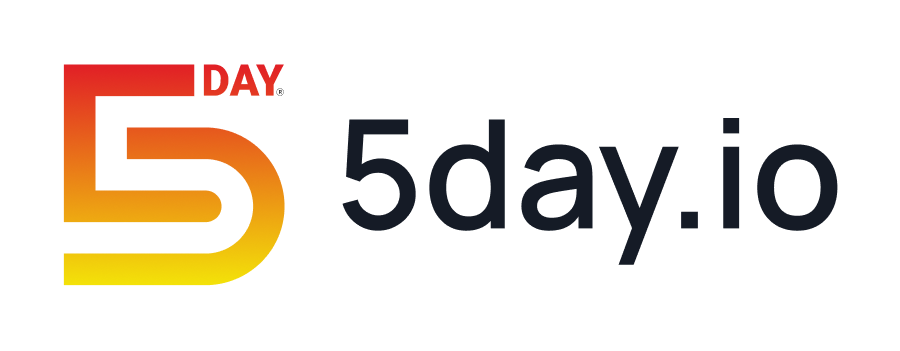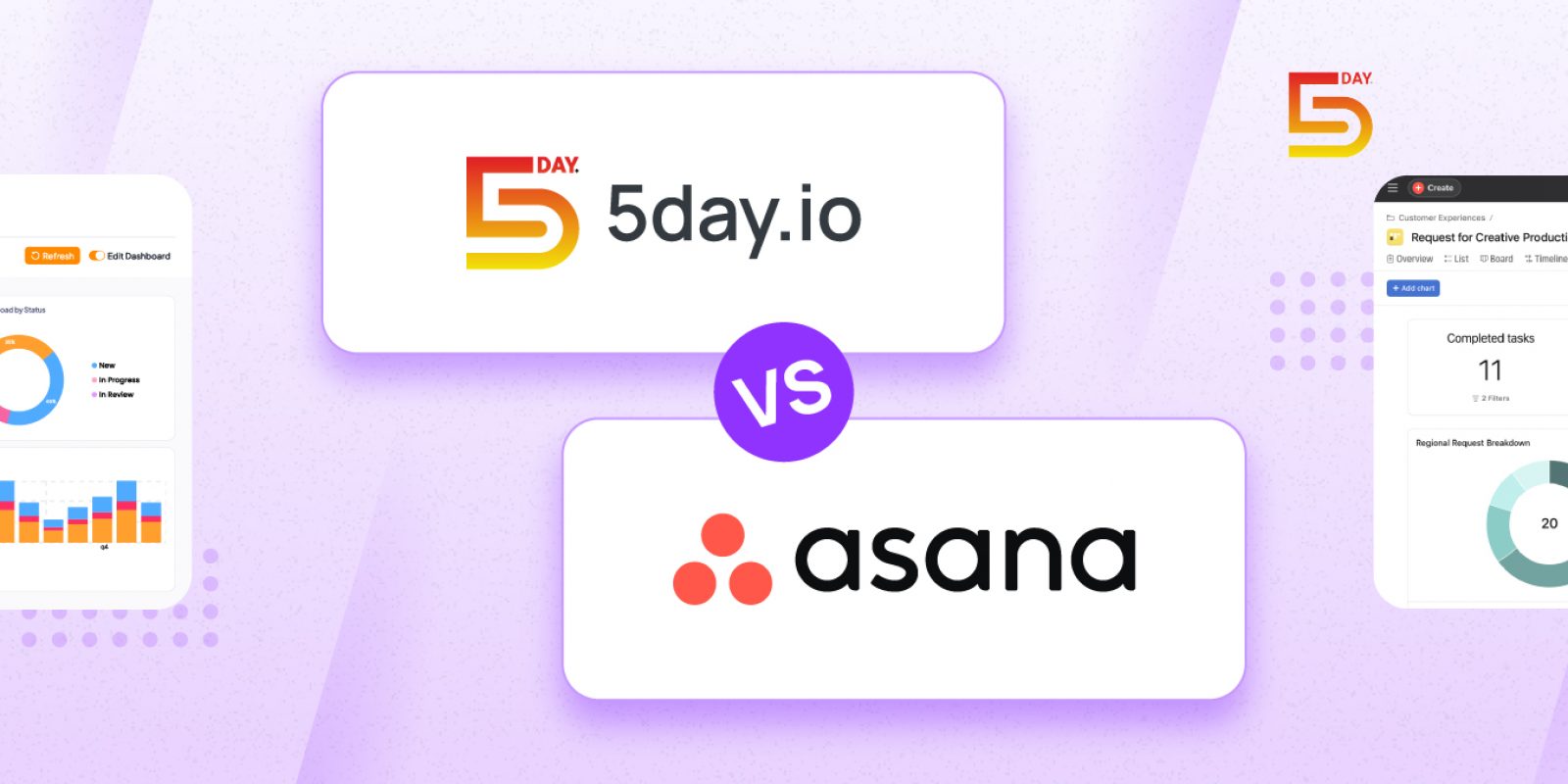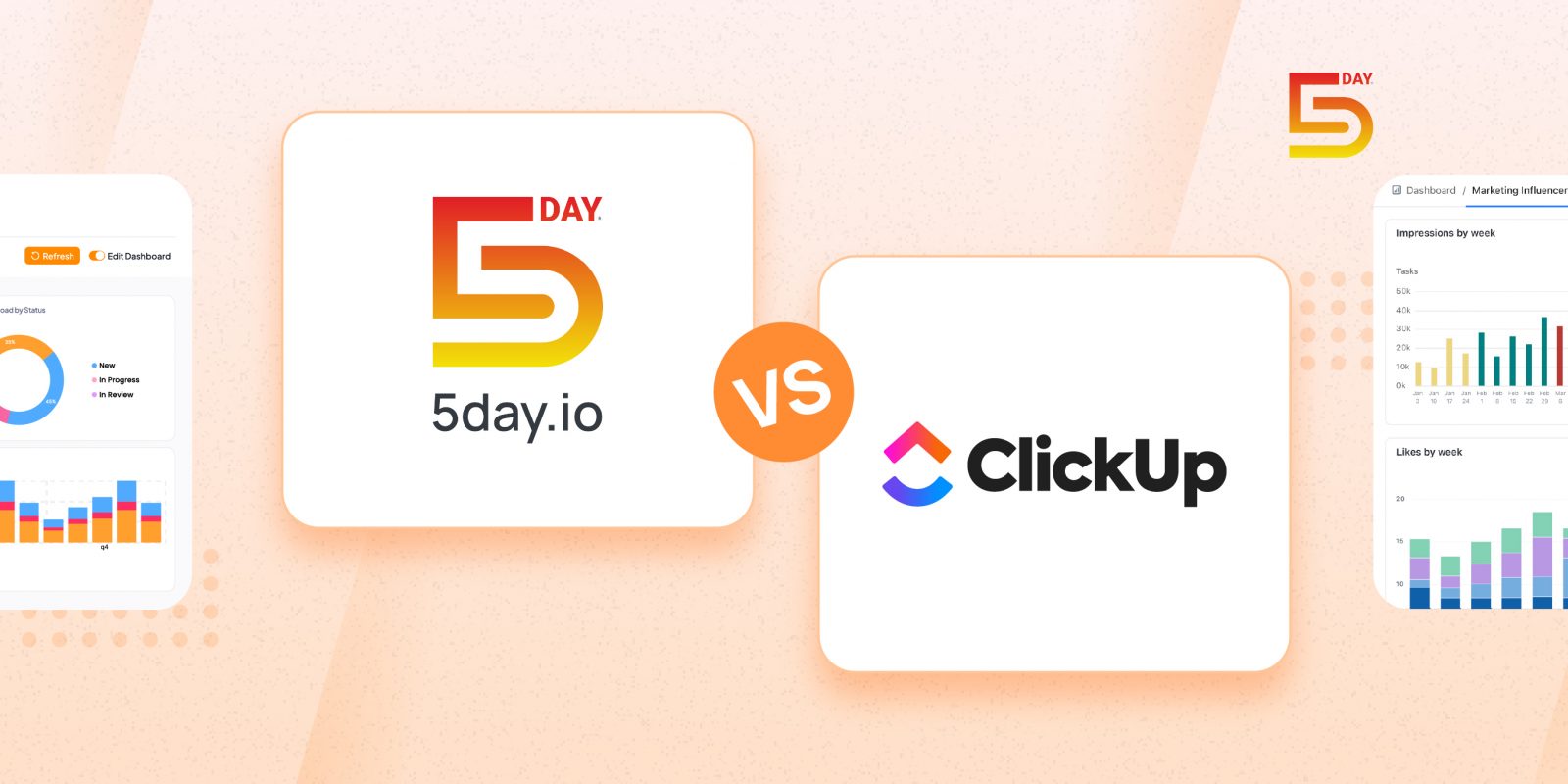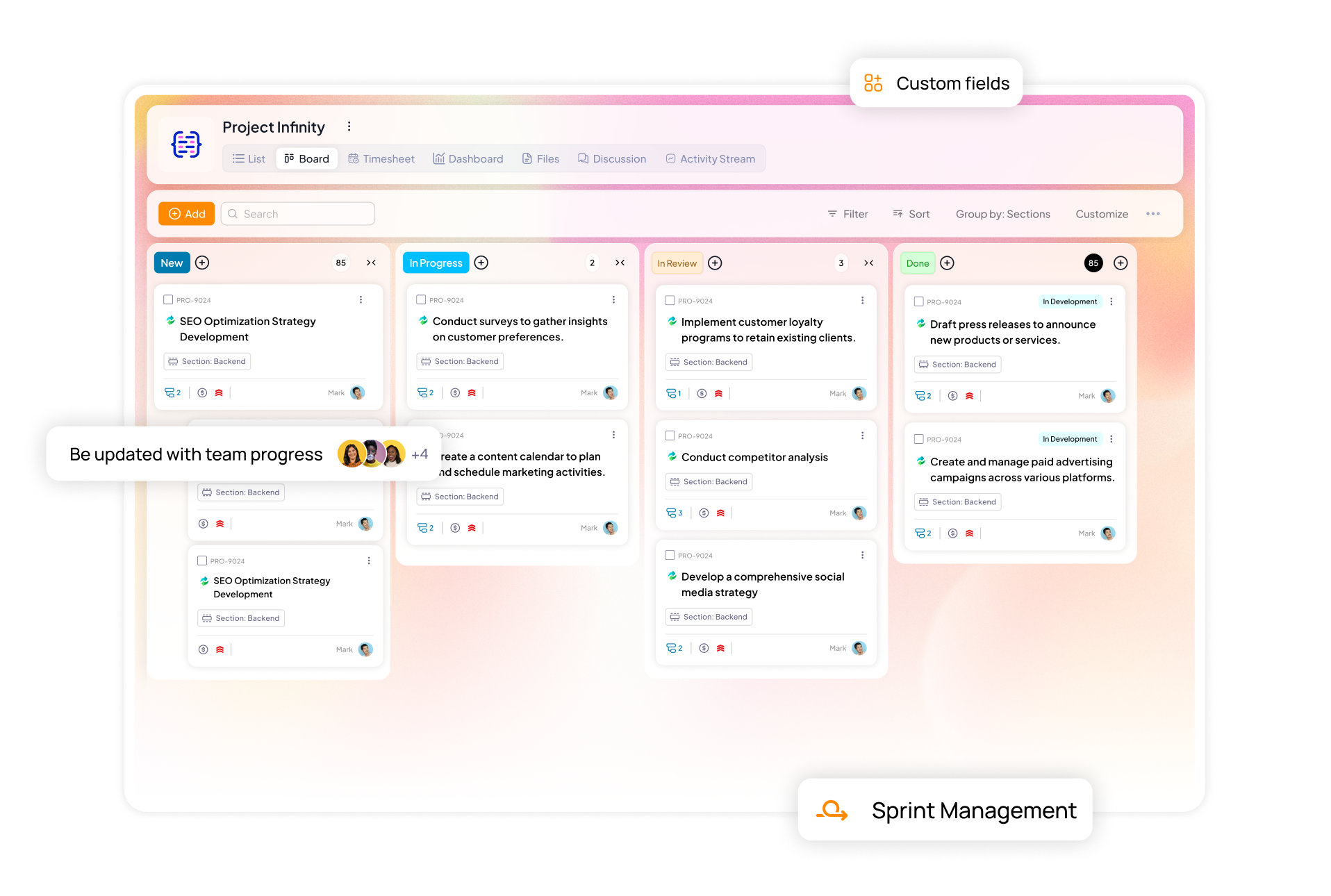Modern marketing teams are doing their best work on broken systems.
Whenever you speak about this in your marketing agency circles, everyone says “You need a better system”, or “You need a new tool”. But why? How do you make the change? What does a tool do differently? These questions keep wandering in your mind.
Because the truth is, most tools weren’t built for the way we truly collaborate today.
Creatives are all moving fast, all trying to stay in sync with systems that were never designed for real-time creativity.
And it’s costing us a lot of time, energy, and joy in the work itself.
The right project management software made for creatives and content creation truly understands your creative process and brings all the dots together. Choosing it right can be just the right thing you need.
In this article, we’ll be going over how project management software like 5day.io can bring order to your content creation process at your marketing agency.
Why content creation workflows are often inefficient
Most content management workflows are duct-taped together. They just happened like patchwork of habits, and half-baked solutions. Even the best creative teams eventually hit a brick wall.
These problems aren’t new. They’re more visible now, because AI is changing the way everything operates, and since we haven’t fully grasped what it can do, we’re holding on to what we already know and expect more results from it.
Hence, creative teams are under immense pressure to go viral every single time. A good tool may be the only way to keep things flowing without buckling down to the pressure.
Here’s where things usually fall apart:
Unclear ownership & deadlines
A piece of content moves through multiple hands before it’s shipped. But who’s driving that journey?
In many teams, the answer is murky. The strategist thinks the writer is handling the situation. The writer’s waiting for visual direction. The account lead is unaware the designer never received the final brief. And deadlines? They’re soft. Negotiable. Shuffled around without consequence.
This lack of ownership leads to the worst-case scenario; everyone assumes someone else is moving it forward, so no one does.
What you need at this point is:
Task-specific ownership | Each part of the workflow must have a clearly assigned owner |
Tied deadlines | Deadlines need to be connected to campaign goals or publishing dates. |
Dependencies and triggers | The next person can’t start until the last one finishes, and that should happen automatically. |
Great content starts with accountability. And accountability starts with a clear workflow system.
Lack of visibility
You’ve got 18 content pieces in motion. A few are in draft. Some are with design. Two are waiting for client feedback.
This is when project managers become human dashboards, spending hours asking people for updates, compiling reports, and chasing down statuses.
What’s needed is more than a client-specific status report. It’s a live, transparent system that gives everyone, from interns to CMOs, an instant view into what’s happening, what’s stuck, and what’s next. That’s what a strong content management workflow delivers.
Scattered feedback loops
Feedback is essential.
But disorganized feedback is toxic. It creates versioning nightmares. When there are too many voices and no single point of final sign-off, work just stalls.
In a high-functioning workflow, feedback is centralized and contextual:
- Comments live with the asset, not across ten tools.
- Feedback has a hierarchy, who must weigh in, and who’s optional.
- Edits are timestamped, documented, and archived for traceability.
Manual coordination fatigue
In many content teams, everyone becomes a part-time project manager.
That’s because your process lacks automation.
Every task requires manual follow-up. Every review needs a reminder.
Great workflow and project management software eliminates this fatigue:
- It automates the check-ins
- Sends reminders
- Blocks tasks until dependencies are done
- Provides in-line updates so people don’t need to ask
You want your team to focus on creative brilliance, instead of waiting around for updates.
Missed publishing workflows
This is where everything breaks down, even if everything else went right. When the exact publishing date and moment is gone, the conversion opportunity also goes out with it. But that’s inevitable when your workflow isn’t integrated with your publishing reality.
They’re caused by poor approval workflows, no escalation paths, and no accountability for time-sensitive deliverables.
A smart marketing project management software that helps content teams bakes in:
- Approver deadlines
- Review stage SLAs
- Automatic escalations to secondary approvers
- Publishing triggers tied to campaign calendars
Content should launch when it’s strategically optimal, not just when it’s finally done.
Also Read: Best Project Management Software for Marketing Agencies
A typical content creation workflow: from idea to publish
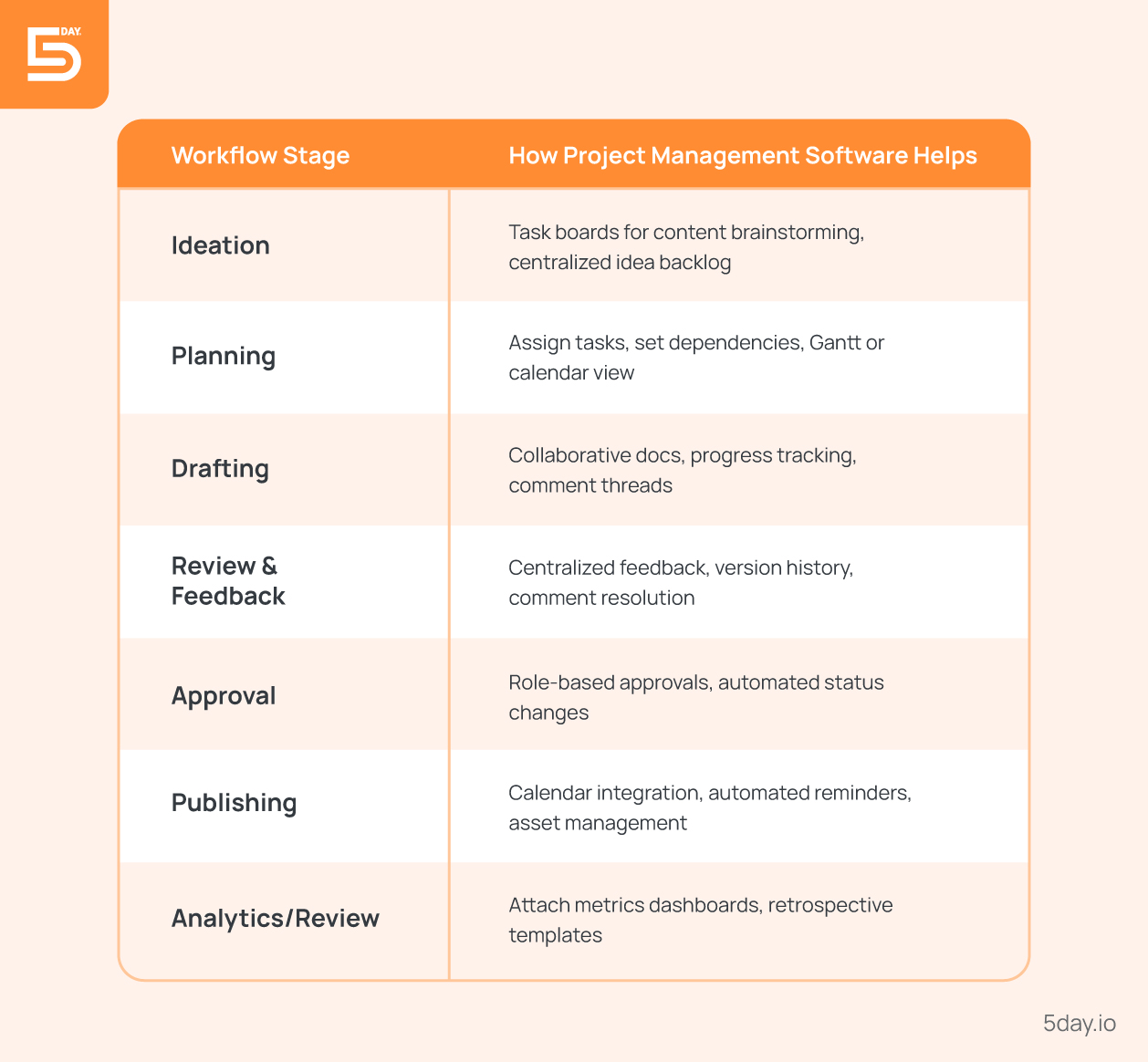
Ideation
This is where good content is born, or where bad content begins to take root.
But most marketing agencies still treat it as an unstructured artform instead of a repeatable system. Brainstorming usually happens in a whiteboard meeting, over Zoom, or within an async Slack thread. People throw in ideas based on gut feel, client comments, or something they saw trending.
What’s missing is a reliable project management process or framework for vetting and organizing those sparks.
With project management software like 5day.io, you can capture ideas at the moment, categorize them by theme or campaign, and assign follow-ups immediately. No idea lives and dies in a brainstorm. It becomes a tracked object, ready to be validated and moved down the pipeline when the time is right.
Market/trend research
This stage involves digging into keyword data, analyzing competitors’ top-performing content, monitoring social chatter, scanning Google Trends, and listening to internal sales/customer success teams. This research phase prevents your content team from creating pieces that no one is searching for or talking about.
Instead of pasting insights across scattered Docs or forgotten Slack threads, a project management tool should allow your strategists to attach market research directly to the ideation card, or the task. That way, every idea is supported by data, and all pertinent information is readily accessible in one central position.
Content calendar planning
It should answer questions like: What are we publishing this week? What’s tied to that product launch in Q3? Which pieces are dependent on external timelines, like PR drops or seasonal moments?
Most teams manage calendars separately from workflows, which creates friction. The writer finishes the draft, but no one remembers when it’s due to go live. Or a campaign gets pushed and half the related assets don’t get moved in time.
With a tool like 5day.io, the content calendar is part of your system. Each item is attached to campaigns, dependencies, and responsible owners. When a launch shifts, so does the content automatically
Planning
Assigning writers/editors/designers
Once ideas are approved, the machine moves to execution. But in most agencies, assignments still happen manually. Assigning roles should align with skill, priority, bandwidth, and ownership instead of just availability. And every person on the task should know exactly what they’re responsible for.
This also includes giving creators the materials they need upfront, brand tone guidelines, approved messaging, audience insights, and previous examples.
A robust project management tool should allow for role-based assignments, linked briefs, due dates, and workload balancing. This means the right person gets the right task at the right time.
Also Read: How to Manage Projects and Tasks on 5day.io?
Deadline setting
So many content delays can be traced back to soft timelines or unclear expectations. “This week” becomes “next week.” Deadlines should never live in someone’s head. They need to be tracked, visible, and tied to dependencies.
In a smart workflow system, deadlines are checkpoints that shift based on upstream changes. If a designer finishes late, the copywriter’s timeline adjusts accordingly. 5day.io manages this with task chaining and visual timelines, reducing missed handoffs and keeping the entire operation in sync.
Drafting
Content creation begins
This is where the creators dive in. But if briefs are incomplete or unclear, this stage quickly derails. Time is wasted on backtracking and guesswork.
5day.io supports smoother drafting by keeping everything in one place. The brief, reference assets, links, and style guide are all attached to the task. There’s no back-and-forth or multi-tool switching. The system supports velocity by reducing the friction around the work, so people can focus on doing, not digging.
Collaborative editing
Most content teams suffer from editing overload: too many voices, too many conflicting opinions, too many disjointed tools. And the original creator is often left trying to merge contradictory feedback with no clear path forward.
True collaborative editing needs structure.
- Who edits first?
- Who gives feedback next?
- Who owns the final changes?
With a proper workflow system, editing happens in stages. The first pass is assigned to the content lead. The second pass to the strategist. Each person is notified in turn, with a timebox for feedback.
Review and feedback
Internal reviews
Internal reviews are your content quality firewall. But if internal reviews aren’t formalized, they become rushed or skipped entirely. Worse, they may happen after the piece has already been sent for approval, leading to rework and delays.
Each piece of content should have a clear internal review stage, with specific people assigned, a checklist to follow, and a strict deadline. If the piece doesn’t pass, it doesn’t move forward.
With 5day.io, this isn’t left to chance. The tool simplifies internal reviews by integrating seamlessly with Google Drive and OneDrive, so files stay attached to tasks and always up to date. Threaded, contextual comments live where the work happens.
External feedback
Save hours of time by bringing project-specific, client-specific feedback into your project management tool. With 5day.io, you can onboard clients with limited visibility using custom roles and permissions, giving them access only to the pieces they need to review, nothing more, nothing less. Clients can drop comments, request changes, or approve work directly within the platform, with full context and without disrupting your internal workflows.
Approval and finalization
Final content sign-off
Content isn’t done until it’s signed off by the right person. But too many teams assume approval instead of confirming it.
Final sign-off must be explicit and visible.
With tools like 5day.io, this is tracked.
Compliance and legal checks
For industries like finance, healthcare, law, or advertising, content can’t go live without compliance review. But legal reviews are rarely creative-friendly. They come in late, drop in vague comments, or use Word docs with tracked changes that don’t sync with your workflow.
This leads to last-minute rewrites, and publishing delays.
The solution? Treat legal as a stakeholder with deadlines and structured input. With 5day.io, legal reviews are integrated into the workflow.
Publishing and distribution
Multichannel publishing needs nuance. What works on a blog won’t work on Twitter. Email subject lines require a different tone than your blog H1.
Instead, your workflow should account for channel-specific execution. Social cutdowns, email variations, ad text, all should be pre-assigned, drafted, and approved before go-live. 5day.io lets you break content down by channel, assign assets and messaging to the right person, and publish or hand off with clarity. That means no missed cues.
Features to look for in content project management software
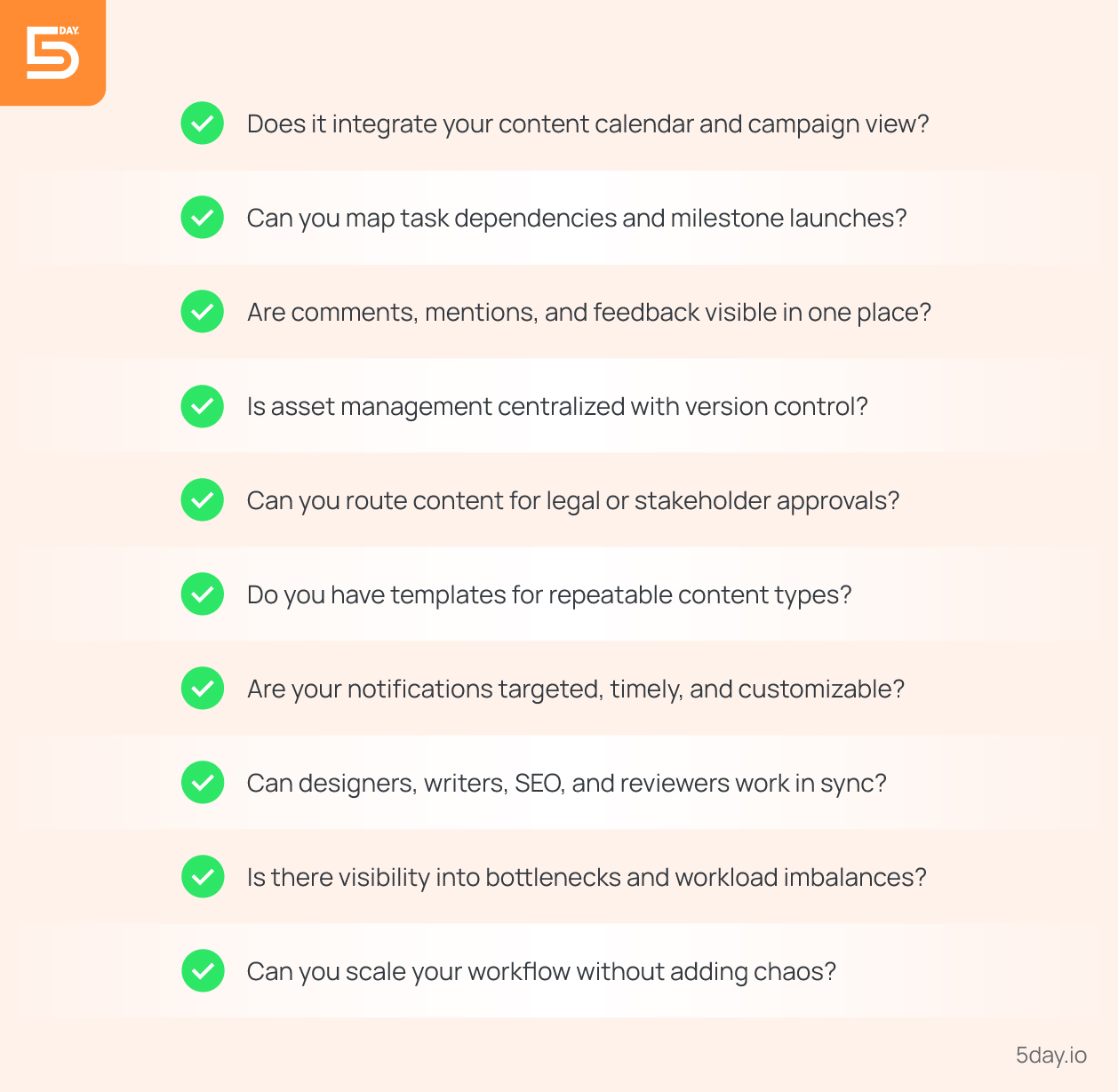
Not all tools are built for content. Here’s what separates a good system from a game-changing one.
Content calendar integration
For agency content teams, your content calendar is a strategic engine that maps deliverables to campaigns. The right content collaboration software integrates this calendar directly into your project view. You can see what’s going live, what’s late, what’s blocked, and who’s responsible. Want to shift a campaign?
Drag and drop one card and all dependencies shifts. Need to align your blogs, social, email, and ads for a product drop? A unified calendar view gives you that 360° snapshot.
Without this integration, your content strategy lives in a vacuum, disconnected from production. You end up relying on memory, Slack threads, or chasing stakeholders.
A truly integrated calendar brings discipline to your content management workflow while still allowing creative fluidity.
Task dependencies & milestones
Dependencies let you map real-world creative flow into your software. When one task shifts, all related deadlines adjust. That means no one gets surprised on a Friday afternoon with a ‘this was due today’ bomb. It also means you can work proactively, see bottlenecks coming, spot overloaded teammates, and plan more intelligently.
Milestones take it even further. They give you fixed points to rally around: a product launch, an event date, a campaign kickoff. Every piece of content can ladder up to those key moments.
Good tools make those milestones visible across projects. Great tools make them foundational.
Built-in collaboration (comments, mentions)
If your team is bouncing between Docs, Slack, emails, and endless Zooms just to review a blog post, you’re drowning.
True content collaboration software needs to bring everything into one place: comments, feedback, questions, approvals, and change requests.
You should be able to tag someone inside a task, ask a question, drop a link, share an image for context, attach a PDF, and keep the entire context in one place. Comments should be threaded. Mentions should trigger alerts. Nothing should get buried. And just as importantly, feedback should be actioned, resolved, and archived.
Creative teams move fast. Feedback should too. When collaboration is built into the workflow, not duct-taped on top of it, you move quicker.
File & Asset management
If your content is scattered across 12 platforms, Google Drive, Dropbox, Figma, email attachments, your team will spend more time searching than shipping.
The right content management workflow must centralize file and asset management. That means every task or content card should contain:
The current working file
- Past versions (archived, not deleted)
- Related assets (briefs, mood boards, tone docs)
- Final deliverables, ready for publishing
Files should be previewable without opening a separate tool.
Approval workflows
One of the biggest content bottlenecks is unstructured approvals. Everyone has an opinion, but no one owns the “yes.” Or worse, someone approves a version, then changes their mind after publishing.
Strong project management tools offer approval workflows, clear, assignable stages that dictate who review what, and when.
Also Read: The 10 Best Project Management Software to Choose From
You should be able to:
- Assign a primary approver per task
- Set deadlines for feedback
- Route content for legal or compliance sign-off
- Track approval history and comments
This brings clarity and protection. It also shortens turnaround time. No more waiting on emails. If someone hasn’t approved, the system reminds them. If they stall, you escalate.
Templates for repeating tasks
Every content team has routines. And yet, so many agencies start from scratch each time. That’s inefficient, and completely avoidable.
The best tools allow you to create task templates with pre-filled checklists, brief structures, required assets, approval steps, and assigned roles. That means when it’s time to write the weekly blog, you’re not reinventing the wheel, you’re pulling from a proven workflow.
Even better, templates reduce onboarding time. New hires or freelancers can jump in and follow the steps, reducing reliance on verbal handovers. And for senior team members, it eliminates mental overhead. They don’t need to remember what’s next. The system does it for them.
In tools like 5day.io, templates can be duplicated with one click and saved for future use.
Notifications & Alerts
If your team doesn’t know when a task is ready, waiting, or overdue, your pipeline slows to a crawl. Smart notifications can be everything for your agency. Too many tools blast irrelevant updates and get muted. The right system lets users control what they see: only tasks they own, only high-priority alerts, only @mentions.
And reminders must escalate intelligently, ping again after 24 hours, flag overdue items, and notify the project lead.
Alerts keep your team accountable without micromanagement. And in high-volume content workflows, that’s the difference between shipping a campaign on time or chasing people for a week.
Cross-functional collaboration
The best content project management tools are built for cross-functional collaboration. That means:
- Assigning different roles to the same task
- Allowing parallel workflows (e.g., legal and SEO reviews)
- Letting people work in their own way, but within a shared framework
Designers should see only their asset tasks, but those tasks should still connect to the parent blog post. Writers should know when SEO edits are due, without needing to chase. Reviewers should be looped in automatically, without requiring a PM to ping them.
When content flows across teams, your entire operation becomes smoother, and infinitely more scalable.
How does 5day.io help you streamline marketing content creation?
Centralized, live marketing content calendar
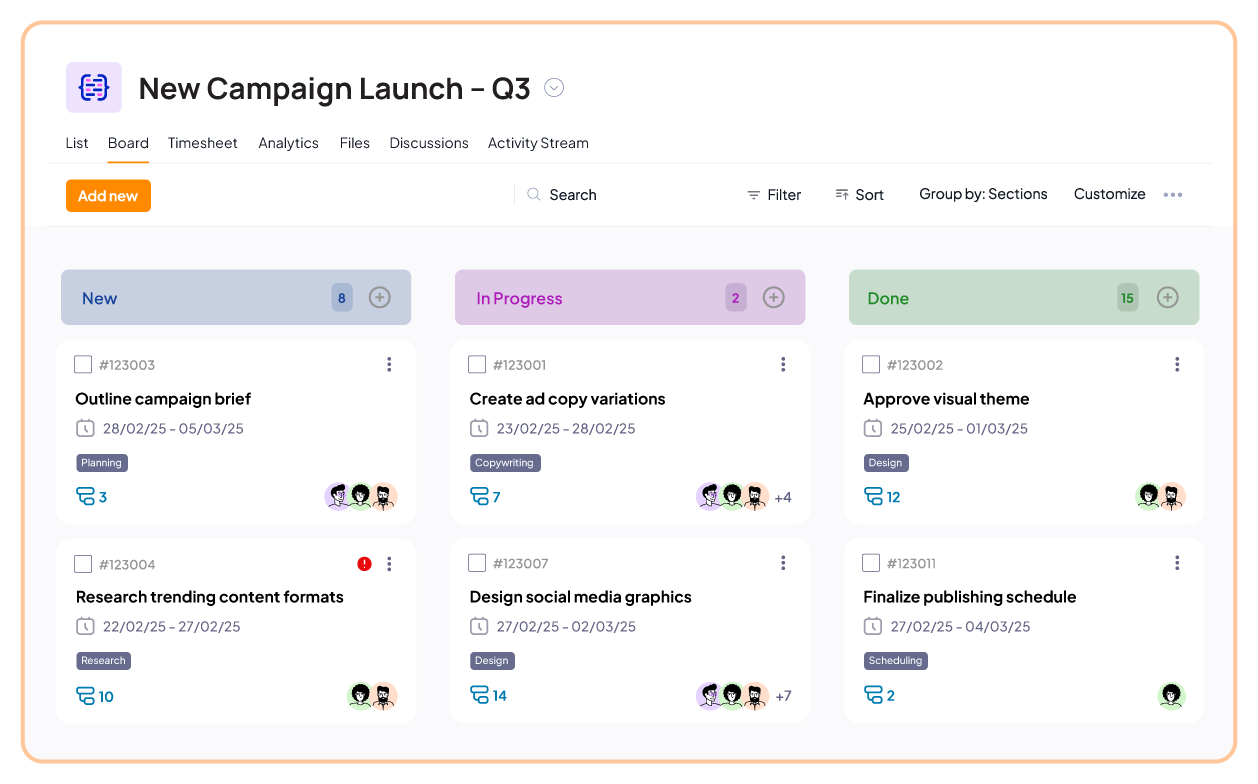
5day.io offers a living, integrated content calendar where every blog post, reel, case study, and newsletter is plotted not just by due date, but by campaign relevance, owner, and production phase.
- You can visualize upcoming content by day, week, or campaign.
- Deadlines are automatically connected to tasks and sub-tasks.
Task dependencies that reflect real creative flow
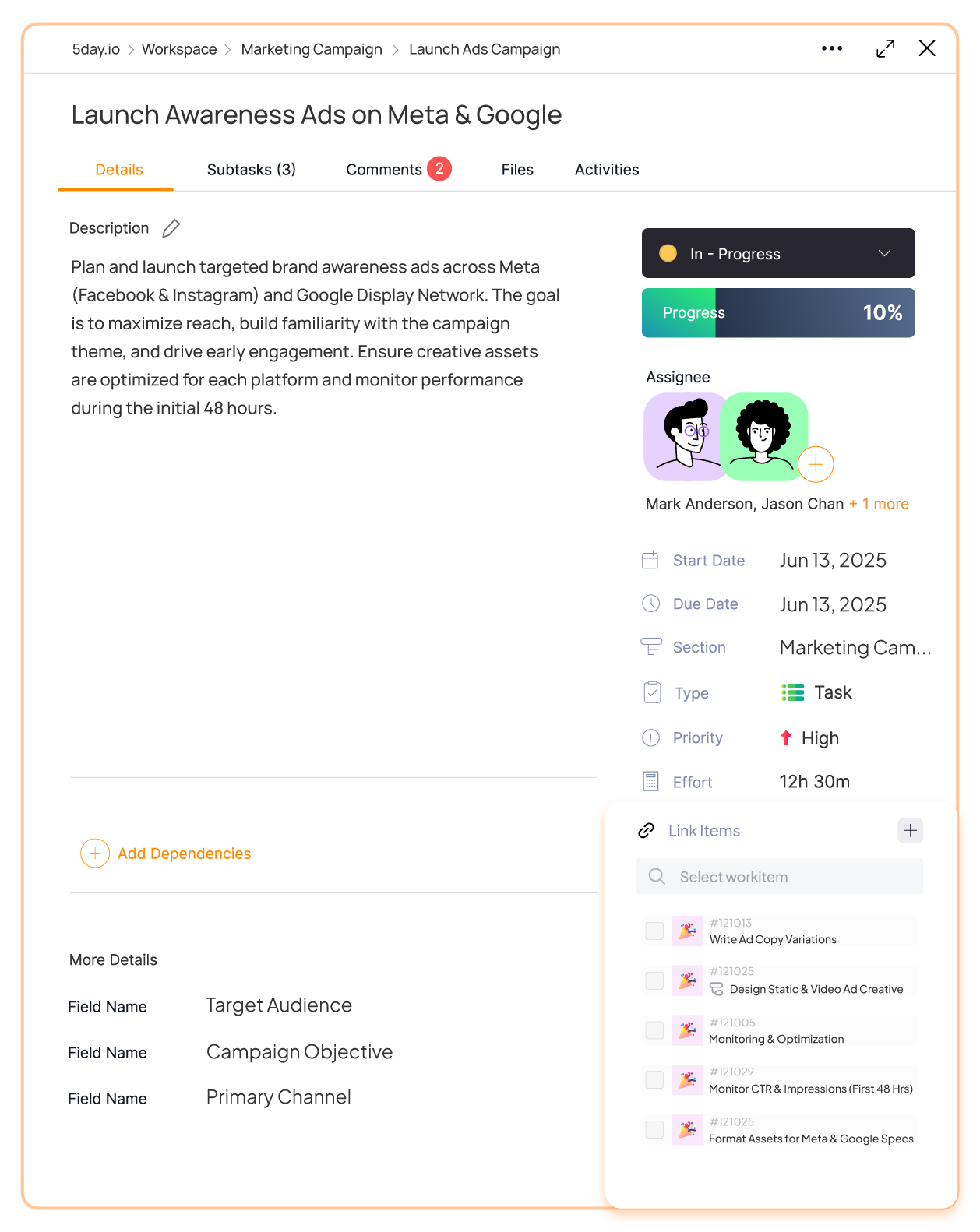
Most project tools treat tasks like isolated checkboxes. But agency content work is sequential and interdependent. 5day.io gets that.
- You can set up linked tasks to show dependency between two or more tasks.
This creates total visibility across your content pipeline and eliminates last-minute surprises.
Structured approval workflows
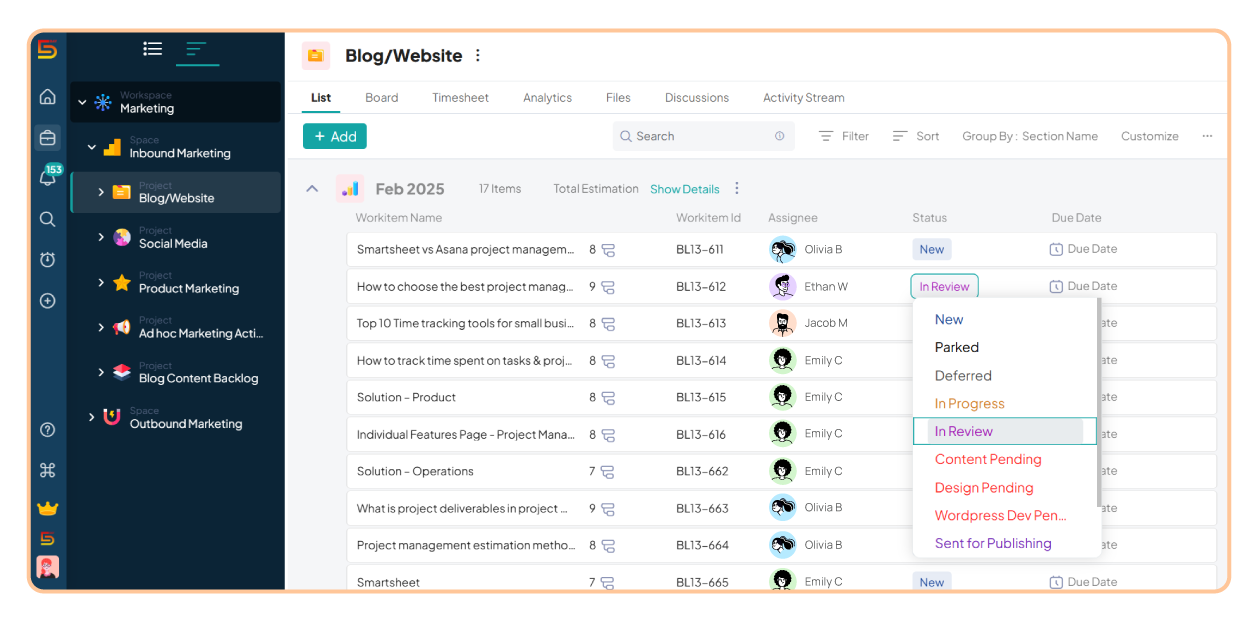
Approvals can be an agency’s biggest bottleneck. 5day.io builds in approval gates as part of the workflow, no more emailing PDFs, chasing WhatsApp messages, or crossing your fingers.
- You can assign who needs to approve, when, and in what order.
- Legal, compliance, client-side reviewers, everyone has a structured place to give input.
- Once approved, content moves to the next stage. This saves agencies hours of manual re-planning and keeps content strategy locked to execution.
Seamless collaboration
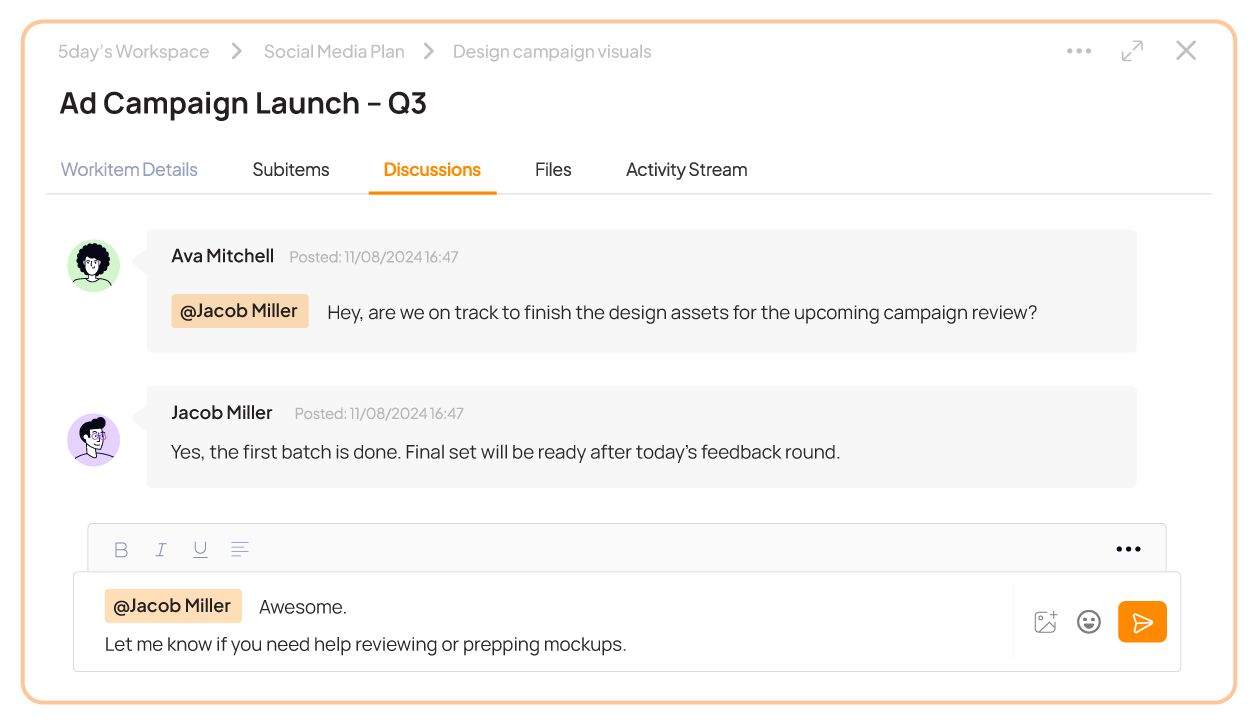
5day.io is built for cross-functional collaboration, meaning:
- Writers, designers, editors, SEOs, and legal can all be assigned to a single content card, each with their own task or sub-task.
- Feedback lives within the card, no more jumping between Docs, Slack, and emails.
- Mentions, comments, and file previews are contextual, not scattered.
Your team works faster because everything, and everyone, they need is right there, in one clean place.
Asset & File management built for content ops
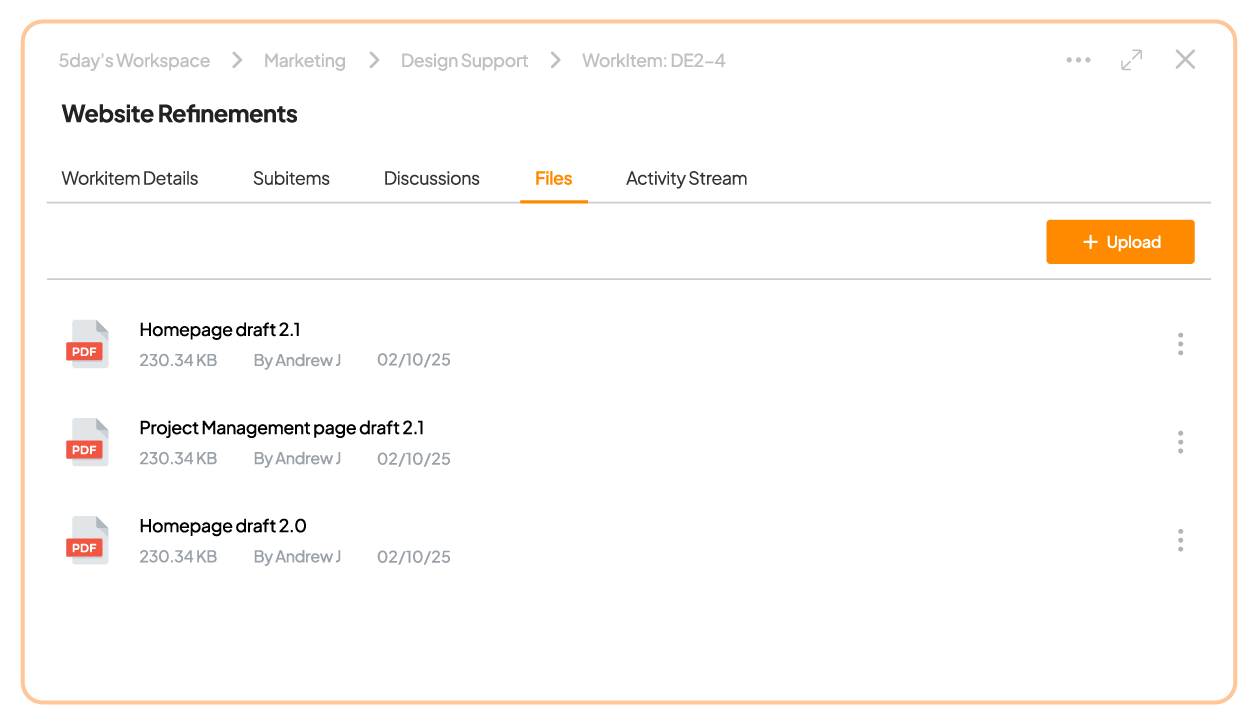
Every piece of content in 5day.io has a single source of truth.
- Upload briefs, design files, video drafts, thumbnails, SEO docs, everything lives with the task.
- This alone can cut hours of back-and-forth from every campaign.
Custom templates for high-velocity content
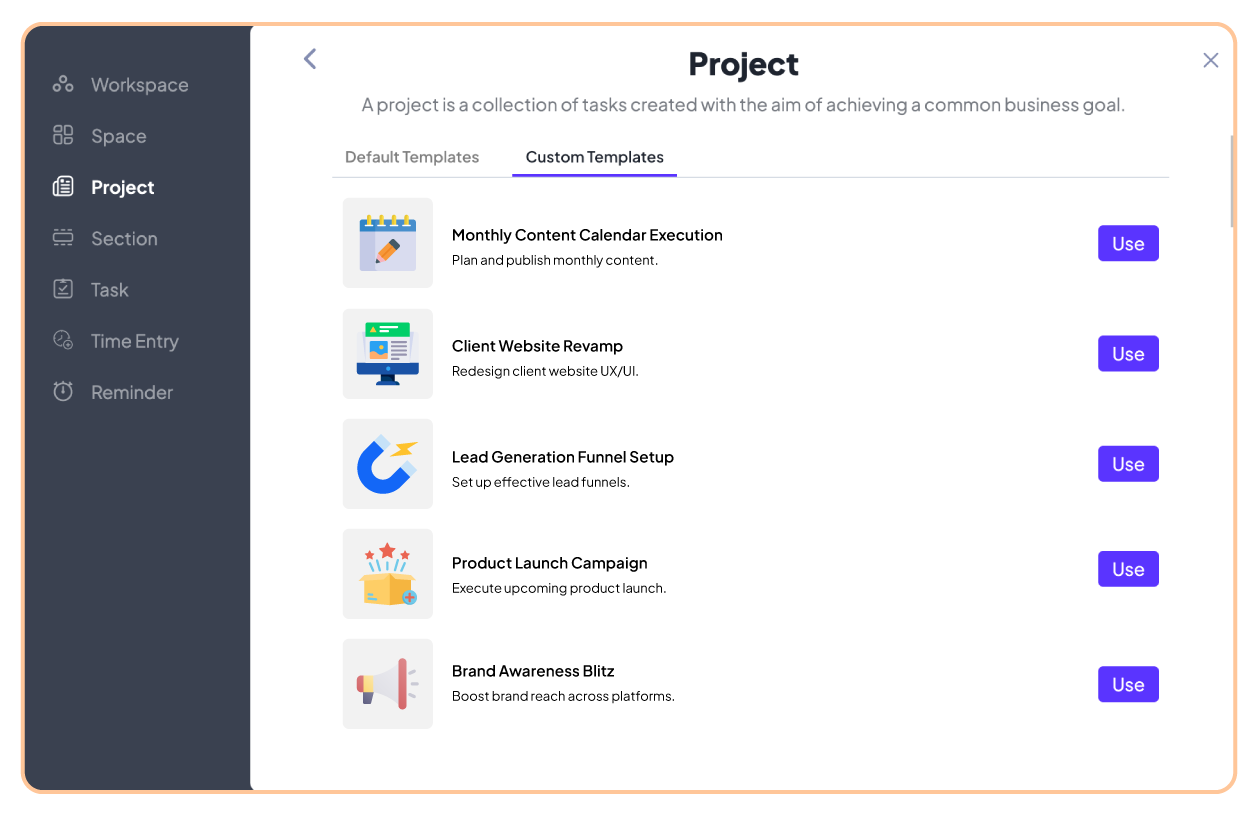
5day.io lets you build templates once and reuse them forever.
- Pre-define the structure for common content types (e.g. draft > review > legal > publish).
- Kick off new content with a single click and trust the system to guide the process.
This reduces onboarding time, speeds up execution, and preserves quality at scale.
Visibility, reporting, and operational intelligence
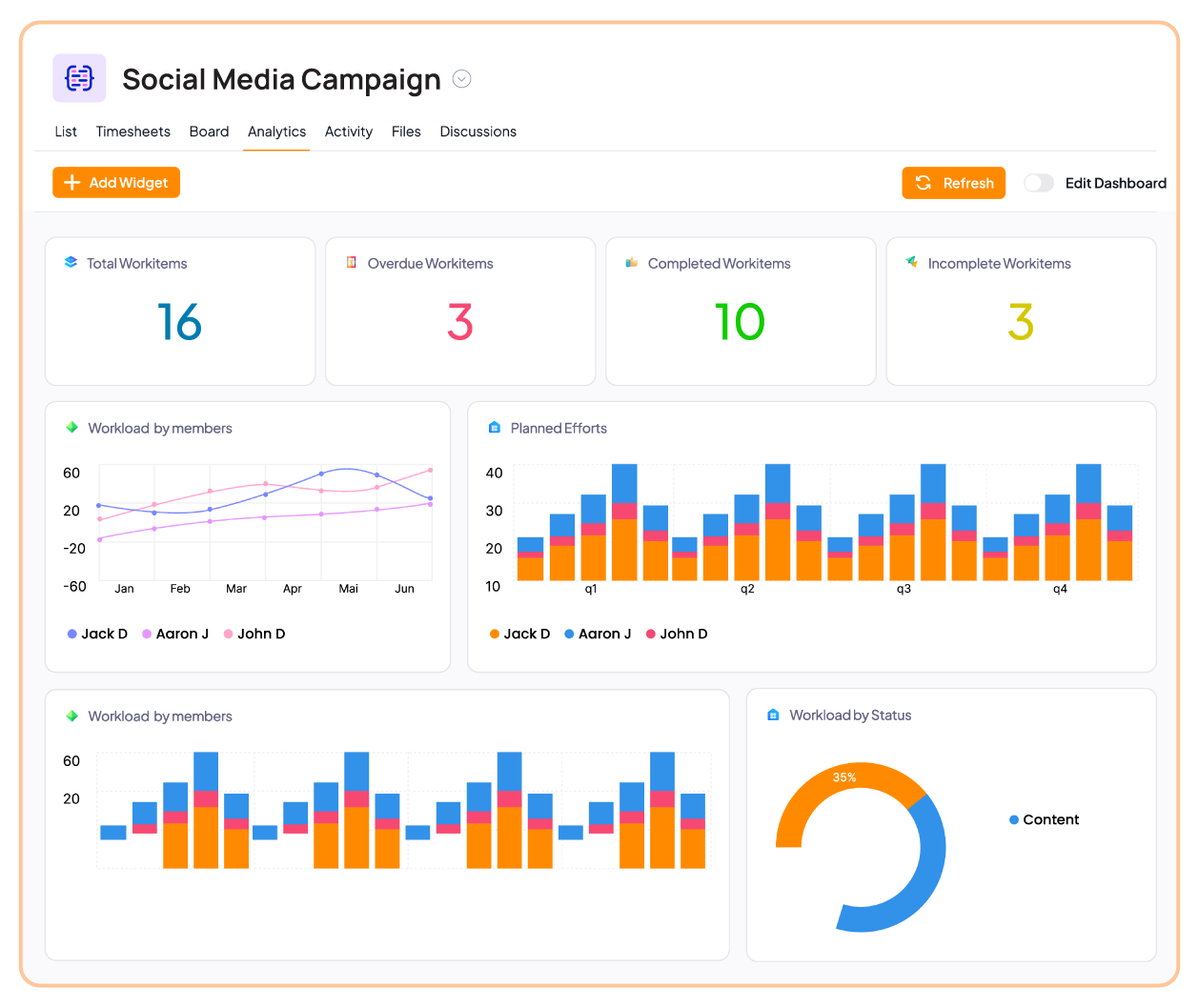
Leads and managers can’t afford to fly blind. 5day.io offers real-time dashboards and views so you can track:
- How many pieces are in flight
- Where things are getting delayed
- Who’s overloaded, and who has capacity
- What percentage of content hits deadlines
This lets you make data-driven calls around hiring, client expectations, campaign scope, and internal bottlenecks.
See the entire tool in action, with all premium-features intact in a 3-month free trial period. Sign up today!
